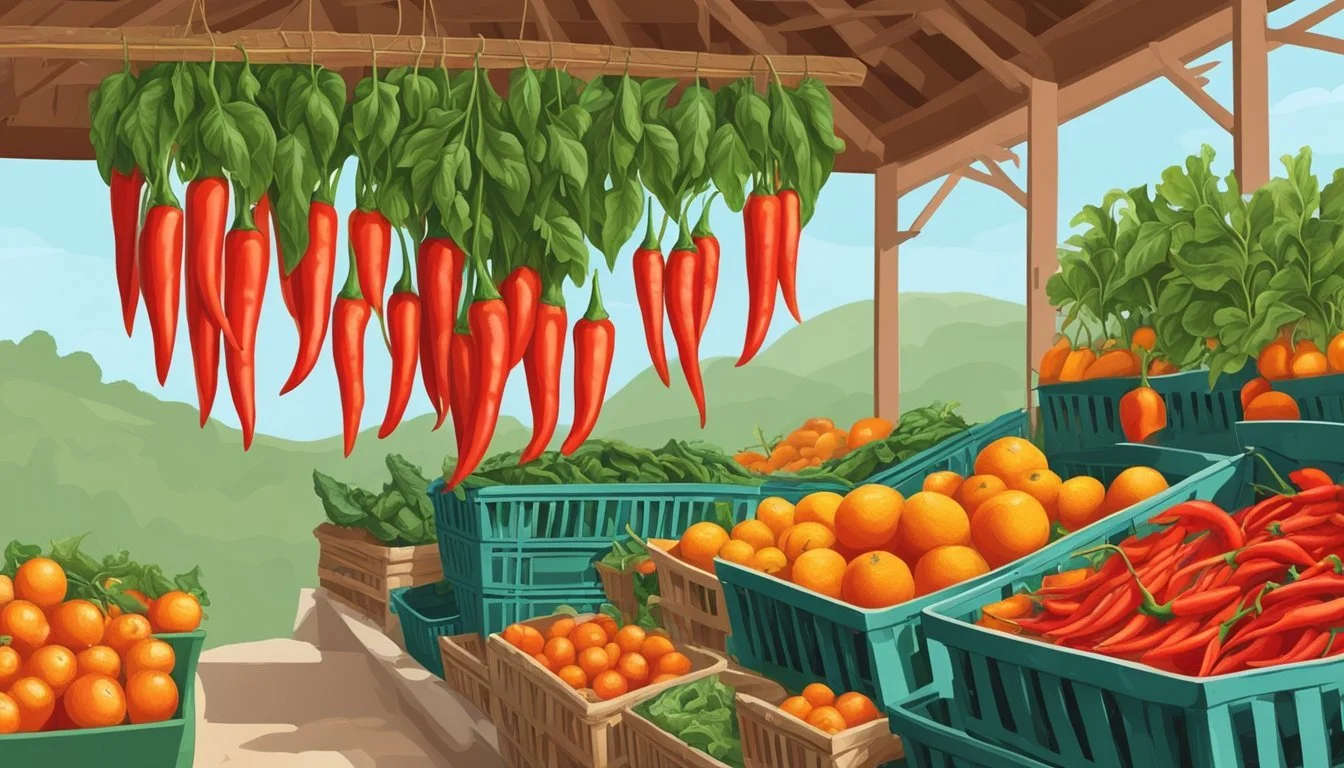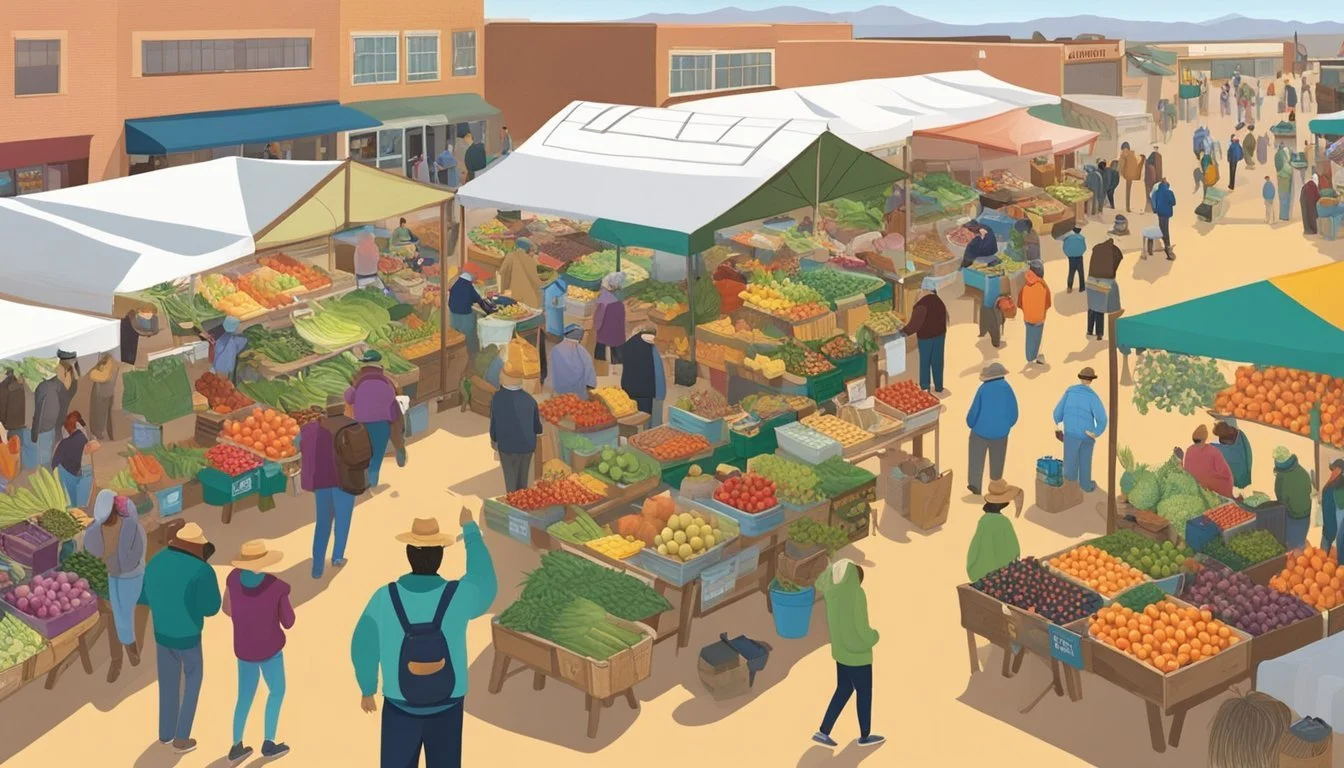New Mexico Seasonal Fruit & Vegetables in February
Your Guide to Fresh Produce Selection
This Article is Part of our New Mexico Seasonal Fruit & Veg Calendar
New Mexico's diverse climate offers a variety of fruits and vegetables throughout the year, and February is no exception. While the state is known for its vibrant summer harvests, winter months like February have their own unique produce offerings that can be found at local markets and farms. Consumers looking to enjoy fresh, seasonal food during this month might find selections more limited than the bountiful summer months, but there are still plenty of nutritious options available.
Among the produce that thrives in February's cool temperatures, leafy greens such as kale (What wine goes well with kale?) and collard greens are readily available. These greens are not only adaptable to the colder weather but are also nutrient-dense, making them a healthy addition to winter meals. While fruit selections are generally scarcer in the winter, options like blood oranges and pomegranates provide a burst of color and flavor to the more subdued winter palette. These fruits, alongside the available vegetables, offer a range of culinary possibilities, from fresh salads to warm, comforting dishes.
Local farmers' markets and grocery stores adapt their offerings based on what is seasonally available. February's fresh produce is a testament to New Mexico's agricultural resilience and the variety that can be enjoyed even during the cooler months. Emphasizing seasonal eating supports local farmers and provides the freshest, most flavorful experience for consumers seeking to incorporate New Mexico's seasonal bounty into their diets.
Overview of New Mexico Seasonal Produce in February
February in New Mexico sees a variety of vegetables that can withstand the winter chill, providing residents and chefs with fresh local flavors.
Vegetables Available
During February, despite the colder temperatures, several vegetables remain in season across the state. Shoppers looking for local produce can find:
Root vegetables: such as carrots and beets, known for their longer shelf life and sweet, concentrated flavors when harvested in colder months.
Leafy greens: including kale and spinach, which tend to be sweeter after exposure to frost.
Cruciferous vegetables: like broccoli (how long does broccoli last?) and cauliflower, which can withstand winter's harsher conditions.
Squashes: including butternut and acorn varieties, still available from late fall harvests.
Legumes: such as pinto beans (how long does pinto beans last?), a staple in New Mexican cuisine, often available dried for use in hearty winter dishes.
Shoppers are encouraged to explore these offerings at local farmers' markets or in the produce section of grocery stores that source from in-state farms.
Selection and Storage Tips
When selecting winter produce in New Mexico, one should aim for freshness and store items properly to extend their shelf life. It is important to choose seasonal varieties for the best flavor and texture while adhering to optimal storage methods to maintain nutritional value.
Winter Squash
For varieties like butternut, acorn, and spaghetti squash, one should look for firm, heavy specimens without soft spots. The skin should be matte and hard, indicating maturity and a developed flavor. Storage: Winter squash keeps well in a cool, dark place for up to a month. Avoid refrigeration as cold temperatures can lead to spoilage.
Root Vegetables
Root vegetables, including carrots, parsnips, and celery root, should feel firm and be free of blemishes or soft spots. The flavor of these vegetables is often sweet and earthy, and they can add depth to winter dishes.
Carrots: Store them in the coolest part of the fridge in a plastic bag to retain moisture and crunch for up to two weeks.
Parsnips: Similar to carrots, store parsnips in a cold part of the refrigerator, ideally in a perforated bag.
Celery Root: Wrap it in a moist paper towel and place it in a plastic bag in the refrigerator to maintain its flavor and firm texture for one to two weeks.
Leafy Greens
Leafy greens such as kale and spinach should showcase vibrant, deep colors with crisp leaves, indicating freshness and high nutritional content.
Kale: Look for dark, robust leaves; kale can be stored in the fridge in a plastic bag, where it will stay fresh for about a week.
Spinach: Select crisp, green leaves without signs of wilting. Refrigerate spinach in an open container wrapped with a damp cloth, and use within three to five days for optimal freshness.
Seasonal Recipes and Preparation Ideas
In February, New Mexico's cooler temperatures are suited for the harvest of hearty vegetables. This section provides several recipes that incorporate seasonal produce like winter squash, cabbage, broccoli, and leeks into delightful dishes.
Salads
Winter Squash & Cabbage Salad
One can slice roasted winter squash and mix it with shredded red cabbage to create a vibrant and nutritious salad. Toss these with a dressing of olive oil, apple cider vinegar, dijon mustard, and a touch of honey for a balance of earthy and tangy flavors.
Sides
Sautéed Leeks and Broccoli
For a simple yet satisfying side, sauté sliced leeks in butter until they are fragrant and start to soften. Add broccoli florets and cook until tender. Season with salt and pepper to taste. This side dish pairs well with a variety of main courses.
Main Dishes
Stuffed Winter Squash
One can use winter squash as a vessel for a multitude of stuffing options. An excellent choice would be a mixture of quinoa (how long does quinoa last?), black beans (how long do black beans last?), corn, and cheese, baked until the squash is tender and the filling is heated through. This creates a hearty main dish that is both flavorsome and fulfilling.
Local Farming and Harvest Information
In February, farms in New Mexico adapt their practices to the climatic conditions, ensuring a productive harvest season. Weather variations and altitude differences across the state play crucial roles in agricultural routines.
Farming Practices
Farmers in New Mexico utilize a selection of cultivation techniques that are designed to accommodate the state’s diverse weather patterns. Crop selection during February is typically conditioned by the cooler temperatures, with an emphasis on cold-tolerant vegetables. Farm practices often involve:
Crop Rotation: To maintain soil health and reduce pest incidence.
Mulching: To regulate soil temperature and conserve moisture.
Protected Cultivation: Utilizing greenhouses or row covers to safeguard against late frosts.
Harvesting Methods
Harvest methods in New Mexico are dictated by crop type and the regional weather conditions. February often sees the collection of hearty produce that can thrive in cooler temperatures. Key harvesting techniques include:
Hand Harvesting: For delicate crops to ensure quality and reduce damage.
Timed Harvests: Scheduled based on weather forecasts and crop readiness, to prevent spoilage.
Harvesting is often done on an as-needed basis, determined by close monitoring of the crop's progress and the regional climate shifts. Whether it is at lower elevations where conditions might be milder or up in the highlands where cooler temperatures dominate, farmers adjust their harvesting schedules accordingly.
Health Benefits of Seasonal Eating
Seasonal eating in February in New Mexico can align with dietary recommendations and boosts the intake of fresh nutrients due to the consumption of fruits and vegetables at their peak freshness and nutritional value.
Nutritional Advantages
Eating seasonally supports a nutrient-dense diet. Fruits and vegetables harvested during their appropriate seasons possess a richer nutrient profile. For instance, vitamin C content in produce like oranges and kale is higher when these foods are in season. They provide antioxidants that support immune function.
Seasonal foods may also present a higher concentration of antioxidants, such as flavonoids, which are natural compounds that contribute to the body's ability to ward off illness. By eating seasonally, individuals benefit from these compounds at their most potent stages.
The diversity of a seasonal diet offers a variety of essential nutrients, encouraging a more well-rounded intake of vitamins and minerals. For example, root vegetables that are available in New Mexico during February, such as sweet potatoes and beets, offer significant amounts of fiber, potassium, and vitamin A.
A diet that includes seasonal fruits and vegetables can align closely with health guidelines, which commonly propose the consumption of multiple servings of produce each day. This ensures that individuals receive a spectrum of nutrients required to support overall health.
Fruit Availability and Variety
In February, fruit selection in New Mexico leans towards citrus varieties, as these tend to thrive in the cooler winter months. It is a time when the consumer can enjoy a range of citrus fruits which are at their peak of freshness.
Citrus Fruits
Blood Oranges: Blood oranges are celebrated for their deep red flesh and are sweeter and less acidic than their relatives. They are typically at the end of their season in February, so availability may vary.
Lemons: The bright and zesty lemon remains a constant in New Mexico's February produce lineup. Consumers can find them readily available and at peak tartness.
Grapefruits: This fruit, known for its slightly bitter yet sweet flavor, is another citrus gem available during this month. Grapefruits continue to be a breakfast staple and a vibrant addition to salads.
Pomegranates: Although generally associated with the fall, some pomegranates can still be found in early February, but their presence is diminishing as the season concludes.
Each citrus variety brings its own unique set of flavors and benefits to the table, enhancing the culinary experiences of New Mexico residents and visitors alike.
Month-by-Month Guide to Produce
In New Mexico, February falls within the winter season, with selections of produce that typically offer hardy winter vegetables and stored harvests from previous seasons. Fresh greens and root vegetables are common, while consumers anticipate the transition to spring's diverse offerings.
January Offerings
Vegetables: Largely comprising storage crops such as carrots, potatoes, and onions, consumers can also enjoy winter-hardy greens like kale and spinach.
Fruits: Citrus fruits, such as oranges and grapefruits, are prevalent, thanks to warmer regions of the state.
March Predictions
Vegetables: Root vegetables remain available alongside a larger variety of greens such as lettuce and Swiss chard, signaling the approach of spring.
Fruits: Citrus fruits persist, but early varieties of berries may start to appear as the month progresses.
Understanding New Mexico's Agricultural Climate
The agricultural climate in New Mexico is defined by its high desert and mountainous regions, which result in varying climatic conditions across the state. These conditions affect the growing season and types of crops that can be cultivated successfully.
Impact of Weather on Crops
New Mexico's climate plays a pivotal role in agricultural output. The weather patterns are characterized by sunny days and cool nights, especially during the growing season. Summer temperatures can soar, impacting crops that are heat-sensitive, while winter brings cooler temperatures that can halt the growth of certain fruits and vegetables.
Spring: A time of moderate temperatures, ideal for the blossoming and growth of many crops, but also a season when late frosts can occur.
Fall: Characterized by milder temperatures and is often the season for harvesting many crops before the first frost.
Agricultural efforts must adapt to this broad spectrum of conditions. Farmers may utilize various methods to protect their crops, such as row covers or greenhouses, during the colder months. The state is known for certain signature crops such as chile peppers, which thrive in the warm, arid climate.
In February, farmers often prepare for the upcoming growing season, as the last of the winter's chill begins to fade. It is a critical time for planning and employing measures to protect the early stages of crop growth from unpredictable weather patterns.
Shopping Locally and Supporting Farmers Markets
When one shops at local farmers markets in New Mexico, they not only gain access to fresh, seasonal produce but also contribute to the state's agricultural economy and the well-being of the community.
Benefits of Buying Local
Local food tastes better. It’s harvested at peak ripeness and makes it to market quickly, resulting in fresh flavors that shoppers can savor. Foods found in New Mexico markets during February could include winter squash, carrots, and a variety of greens.
Nutritional value is often higher. Produce sold at local New Mexico farmers markets is less likely to have lost nutrients to long transit times, which can be the case with some supermarket fare.
Supports New Mexico’s economy. By purchasing from state farmers, funds remain within the local economy, aiding in its health and sustainability. Every dollar spent is a direct investment into New Mexico's agricultural sector.
Sustainability benefits. Local farms typically employ practices that are mindful of the environment, particularly smaller-scale operations. Buying local leads to a reduced carbon footprint due to shorter travel distances for the produce.
Cultural connection. Shopping at farmers markets allows individuals to engage with New Mexico's farming community, preserving and nurturing the state's unique agricultural heritage and traditions.
Community health advantages. Farmers markets can increase access to fresh foods in underserved areas, improving the overall health profile of local communities.
By prioritizing purchases from local farmers and markets, one supports the fabric of New Mexico's agrarian-focused communities, strengthening both the economic and nutritional foundations of the state.











